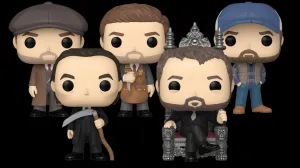With Star Wars: The Rise of Skywalker now in theaters, fans are witnessing not only the end of the sequel trilogy, but of the entire Skywalker Saga. With more than 40 years of mythology to weave together, the film is packed with plot points and narrative beats which, understandably, can cause quick confusion. From the fates of various characters to the new mythology elements introduced, or things that were at least new to you, we’re here to help break down what the ending of the film means and how it ties to the various other corners of the Star Wars franchise.
Videos by ComicBook.com
WARNING: Spoilers below for The Rise of Skywalker
As evidenced by the trailers, Emperor Palpatine returned as an antagonist despite his seeming demise in Star Wars: Return of the Jedi, leaving audiences to wonder how it was possible. Even after seeing the movie, you might still be confused as to how Palpatine returned, and you’re not alone. It is never clearly stated how Palpatine could be alive, though his frail appearance and his reliance on the various tubes and wires connected to him imply that he is only just barely physically living, despite his connection to the Force being stronger than ever.
With the film confirming that those extremely attuned to the Force could heal injuries and even revive those who had died, it would seem like the explanation would be the most simple one, which is that his body was recovered and he was revived with the help of Sith Lords. The film also offers a glimpse of a cloning vat in which appear multiple bodies resembling Snoke, but with the film never diving more fully into that notion, it’s unclear what the significance of these clones was. However, Palpatine did claim that he “created” Snoke, with audiences still wondering if this should be interpreted figuratively or literally, though we can assume those answers will be revealed somewhere further down the line. All we know is Palpatine was the puppet master pulling the strings on Kylo’s entire descent to the Dark Side.
Much like his grandfather before him, Kylo Ren ultimately abandoned his devotions to the Dark Side of the Force, instead reverting back to his former identity as Ben Solo. This was accomplished thanks to Leia using every ounce of her Force abilities to connect with “Kylo,” who, when realizing his mother was still there for him, reverted back to being Ben. While Leia may have passed, it wasn’t until Ben used his Force powers to bring Rey back to life after her fatal confrontation with Palpatine and became one with the Force that Leia also became one with the Force. This helped demonstrate that, while she may have physically passed, Leia wasn’t really gone until her son also used his final moments to become one with the Force like many Jedi before him.
Speaking of the final duel with Palpatine, Rey knew she had to kill him to end the threat once and for all, though the villain himself admitted that, were she to strike him down in anger, his hatred would flow into her, allowing him to continue his reign. When all hope seems lost, Rey begins hearing the voices of all the Jedi that came before her, from Yoda to Obi-wan to Mace Windu, empowering her to stand tall against the Emperor, resulting in his death. Since he wasn’t struck down in anger, he wasn’t able to continue his villainy through Rey.
With this being the final entry in the entire saga, many fans had wondered if we’d see iconic characters return, even as Force ghosts. At the end of the film, Rey buries her inherited lightsaber that previously belonged to Anakin and Luke Skywalker, as well as Leia’s lightsaber. When she does this, Luke and Leia appear to her as Force ghosts with no other Force ghosts appearing. Rey ignites her own lightsaber, which is yellow, possibly blending the red of Kylo’s lightsaber with the green of Luke’s lightsaber used in Return of the Jedi. Rey’s embrace of what it means to be a Skywalker is confirmed in the film’s final moments, as she tells an old woman that her name is “Rey Skywalker,” rejecting her true lineage as Palpatine’s granddaughter.
Arguably one of the most emotional moments in the film came when Maz Kanata gave Chewbacca the medal that Leia had been holding when she died. More than this just representing a token of his friendships with Luke, Han, and Leia, the Wookiee famously wasn’t given a medal on Yavin 4 after the destruction of the Death Star, with the pilot finally earning the emblem he so deserved.
A new introduction to the saga with The Rise of Skywalker was Jannah, played by Naomi Ackie. With the film also seeing the return of Billy Dee Williams as Lando Calrissian, some assumed Jannah would be related to Lando, only for audiences to learn that she was also a former stormtrooper who never knew who her family was. It seems unlikely that the two had any previous connection, though Lando offers to help her find out who she was, seemingly igniting a new connection, even if it wasn’t familial. Finn, meanwhile, never mentions that he plans to find his own family, though he did surprise audiences by hinting that he had a mild connection to the Force.
Williams wasn’t the only star from the original trilogy to make a return, as Denis Lawson, who played Wedge Antilles in the original trilogy, appeared in the final Resistance fleet to lend assistance against the Final Order.
Fans are still left with a number of questions, like how Maz got the Skywalker saber ahead of Star Wars: The Force Awakens or what Finn was so desperate to tell Rey before being repeatedly interrupted, but between the film’s home video release and the creation of new Star Wars comic books, we won’t be surprised if these questions are answered further down the line.
Star Wars: The Rise of Skywalker is in theaters now.
What did you think of the movie? Let us know in the comments below or hit up @TheWolfman on Twitter to talk all things Star Wars and horror!








